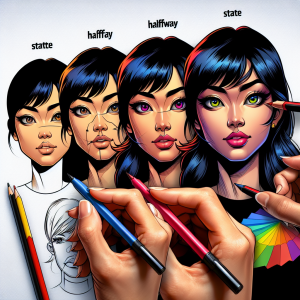The Enduring Popularity of Underdog Cartoons: Tapping into the Universal Appeal of Triumph Against the Odds
Introduction
The underdog story has been a staple of storytelling for centuries, and nowhere is it more prevalent than in the world of cartoons. From classic characters like Scooby-Doo and the Mystery Inc. gang to more modern creations like SpongeBob SquarePants and Steven Universe, underdog cartoons have captured the hearts and imaginations of audiences around the world. But what is it about these characters and their stories that make them so enduringly popular? In this article, we’ll explore the universal appeal of triumph against the odds and why underdog cartoons continue to resonate with audiences of all ages.
The Appeal of the Underdog
At its core, the appeal of the underdog lies in the universal experience of feeling overlooked, underestimated, or out of place. Whether it’s a group of kids solving mysteries in their hometown or a talking sponge working in a fast-food restaurant at the bottom of the ocean, underdog characters often find themselves in situations where they are perceived as unlikely heroes. This underdog status allows audiences to root for the characters as they overcome obstacles, defy expectations, and ultimately triumph in the face of adversity.
Underdog cartoons often feature themes of friendship, teamwork, and perseverance, which are values that resonate with viewers of all ages. These stories show that even the most unlikely heroes can make a difference, and that with determination and a little help from their friends, anything is possible. This message of hope and resilience is what makes underdog cartoons so captivating and enduring.
The Role of Humor and Heart
In addition to their universal themes, underdog cartoons also draw audiences in with their blend of humor and heartfelt storytelling. Characters like Shaggy and Scooby-Doo or Patrick and SpongeBob provide comic relief with their humorous antics, while also forging deep connections with audiences through their loyalty and bravery. Their ability to make audiences laugh while also tugging at their heartstrings is a powerful combination that keeps viewers coming back for more.
Moreover, the challenges faced by underdog characters often mirror real-life struggles, making their triumphs all the more meaningful. Whether it’s overcoming personal insecurities, standing up to bullies, or facing seemingly insurmountable odds, underdog cartoons show that everyone has the potential for greatness, regardless of their background or circumstances. This blend of humor and heart creates a powerful emotional connection with audiences, making underdog cartoons not just entertaining, but deeply meaningful as well.
The Enduring Popularity of Classic Underdog Cartoons
Many classic underdog cartoons continue to be beloved by audiences decades after their initial debut. Scooby-Doo, for example, first aired in 1969 and has since become a cultural icon, spawning numerous spinoffs, movies, and merchandise. The enduring popularity of these classic cartoons can be attributed to their timeless appeal, which continues to resonate with each new generation of viewers. The characters, themes, and humor of these cartoons have transcended time and remain just as relevant and engaging today as they were when they first premiered.
Modern Underdog Cartoons: Tapping into the Zeitgeist
In recent years, underdog cartoons have continued to thrive with the creation of new characters and stories that tap into the current cultural zeitgeist. Shows like Steven Universe and The Amazing World of Gumball have reimagined the underdog story for a new generation, exploring themes of identity, diversity, and empathy in a way that resonates with modern audiences. These shows demonstrate that the appeal of the underdog is as relevant today as it has ever been, and that there is always a place for stories of triumph against the odds in our ever-changing world.
The Impact of Underdog Cartoons on Audiences
The enduring popularity of underdog cartoons speaks to their profound impact on audiences of all ages. These stories provide inspiration, comfort, and a sense of belonging to viewers, showing them that no matter who they are or where they come from, they too can be heroes in their own right. The positive messages and values embedded in underdog cartoons have the power to influence and shape the worldview of those who watch them, making them an important and enduring part of popular culture.
FAQs:
Q: Why do underdog cartoons continue to be popular?
A: Underdog cartoons continue to be popular because they tap into the universal appeal of triumph against the odds, offering viewers a sense of hope, inspiration, and relatability.
Q: What makes underdog cartoons so enduring?
A: Underdog cartoons endure thanks to their timeless themes, blend of humor and heart, and their ability to connect with audiences on a deep emotional level.
Q: Are underdog cartoons only for kids?
A: While underdog cartoons are often targeted towards children, their universal themes and messages make them enjoyable and meaningful for viewers of all ages.
Q: What impact do underdog cartoons have on audiences?
A: Underdog cartoons have a profound impact on audiences, providing inspiration, comfort, and a sense of belonging, while also shaping the worldview of those who watch them.
In conclusion, underdog cartoons have endured for generations because they tap into the universal appeal of triumph against the odds, offering viewers a sense of hope, inspiration, and relatability. Their blend of humor and heart, timeless themes, and ability to connect with audiences on a deep emotional level make them not just entertaining, but deeply meaningful as well. Whether it’s classic characters like Scooby-Doo or modern creations like Steven Universe, underdog cartoons continue to captivate and inspire audiences of all ages, proving that the underdog story is as relevant and enduring as ever.








+ There are no comments
Add yours